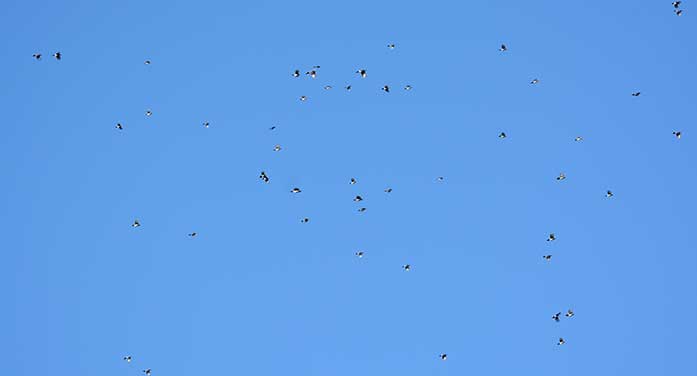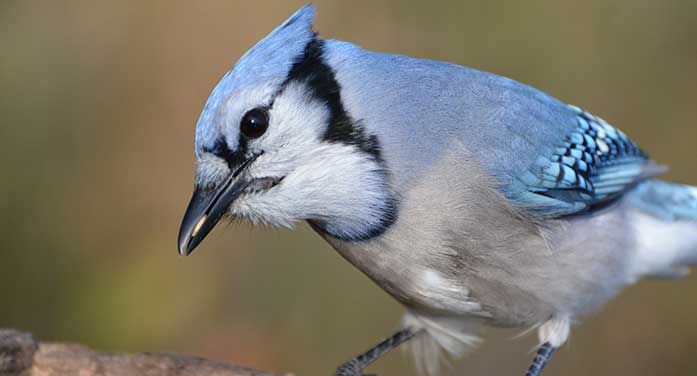 Although there are many references to the autumn passage of blue jays (cyanocitta cristata) through Ontario and Eastern Canada in literature, the migration isn’t well documented from a quantitative perspective.
Although there are many references to the autumn passage of blue jays (cyanocitta cristata) through Ontario and Eastern Canada in literature, the migration isn’t well documented from a quantitative perspective.
The fall passage of blue jays through Ontario has long been observed, with reports at least as early as 1906 by the famous naturalist Arthur Cleveland Bent at Point Pelee National Park. Often huge numbers of birds migrate out of the province annually, during a few weeks in September and October.
The blue jay is one of 11 species of North American jays and is a familiar part of Eastern Canada’s avifauna. It ranges across much of south-central Canada, but is generally absent from the territories and its presence in British Columbia is patchy.
It’s considered a year-round resident throughout much of the eastern and central United States, east of the Rockies and south to the Gulf of Mexico. In Ontario, its range includes all of the central and southern parts of the province, and extends north and west from Sudbury to Thunder Bay.
 Its North American population is reported to be about 22 million and has remained stable over the past 40 years. Except in the extreme southern parts of its North American range, about 20 per cent of the population is migratory.
Its North American population is reported to be about 22 million and has remained stable over the past 40 years. Except in the extreme southern parts of its North American range, about 20 per cent of the population is migratory.
In Ontario, the blue jay is closely associated with forests having high proportions of beech, oak and beaked hazel, so when crops of acorns, beechnuts and hazelnuts are poor, jays migrate out of the province in greater numbers. There’s a direct correlation between the availability of mast from oak, beech and hazelnut and blue jay fall flight numbers. The poorer the crop, the more jays migrate.
The migratory path of blue jays in autumn follows the edges of major waterways, with the north shores of lakes Ontario and Erie representing major pathways. In Ontario, the general flight direction is mostly from an east/southeast to a west/southwest direction, from treetop level to 300 metres.

The migratory path of blue jays in autumn follows the edges of major waterways, with the north shores of lakes Ontario and Erie representing major pathways
The jays travel in loose strings involving a few to hundreds of birds.
In the spring, smaller less obvious movements occur, but these are not as closely linked to major waterways so are not as evident.
There are many records of large movements of blue jays through Ontario in the fall but most are not adequately quantified. Where records do exist, often the reporting is inconsistent or sporadic, primarily due to a lack of dedicated counters. At Holiday Beach Migration Observatory (HBMO) in Essex County, Long Point Bird Observatory (Norfolk County) and Prince Edward Point Bird Observatory (Prince Edward County), numerous records have been documented over the years, with efforts made to report numbers seen.
But it’s seldom reported how the numbers were generated or how confident the observers were in the numbers. It’s presumed that when higher numbers are published, the observers are doing block or time counts to estimate the number of birds going by.
The two hawk monitoring stations, located along the Lake Erie shore (Hawk Cliff and HBMO), annually record the passage of tens or hundreds of thousands of blue jays. Based on data on the HBMO website, their 28-year average is 292,126 jays a year. This number is somewhat lower than the actual number of jays that pass the observatory, because on some days, during the peak of the migration, no counts were conducted, no jays were reported or only a general reference was made to their passing.
The numbers of jays observed at peninsulas along the Lake Erie shore are much lower than one might expect, due their proximity to these stations. The highest daily numbers reported at Long Point, Point Pelee and Rondeau were 7,200, 10,000 and 15,000, respectively. Typically, most records in these areas were for 100s or low 1,000s of birds.
This may be explained by the presumption that the majority of the jays are closely following the east-west Lake Erie shoreline and seldom stray too far from this path, avoiding long southerly flights to follow the jutting shore at Long Point, Rondeau and Point Pelee. Niagara Region, Hamilton, Kingston and the Sarnia River valley frequently experience modest, but never large, movements of birds in the fall.
Holiday Beach Migration Observatory – Highest Daily Count 2001-2010
| Year | Date | # of Jays |
| 2001 | Sept. 28 | 264,410 |
| 2002 | Oct. 6 | 150,001 |
| 2003 | Sept. 28 | 79,863 |
| 2004 | Oct. 10 | 74,410 |
| 2005 | Oct. 4 | 34,040 |
| 2006 | Sept. 29 | 55,659 |
| 2007 | Sept. 28 | 54,270 |
| 2008 | Oct. 4 | 68-74,000 |
| 2009 | Oct. 1 | 158,300 |
| 2010 | Oct. 9 | 41,000 |
The typical peak migratory period occurs between approximately Sept. 15 and Oct. 15, with the greatest numbers reported in late September and early October.
It’s often difficult to analyze the correlation between weather conditions and the flight magnitude, since much of the data are reported in a manner that doesn’t show these correlations. For example, the weather for a given day is accurately reported at the hawk watches but the timing of the blue jay flights is not. If the winds are good in the morning and shift to a more southerly direction midday, the data often don’t indicate the time the jays started and stopped moving.
A review of the weather data reported on the HBMO website indicates that the most favourable conditions, during the first and middle parts of the migratory period appear to involve light winds from a northerly or easterly direction, with cold or cool overnight temperatures, followed by warm daytime temperatures.

The blue jay is one of 11 species of North American jays and is a familiar part of Eastern Canada’s avifauna
Persistent rain and strong, sustained winds, in excess of about 15 to 20 km/h, greatly hinder or halt migration. Later in the season, lights winds from almost any direction don’t seem to unduly influence the migration, as the urge to migrate overwhelms the impacts of less-than-ideal migratory conditions. To demonstrate this, several strong flights at HBMO in early October 2010 occurred under rainy, blustery conditions or very unfavourable winds.
Much more work is needed to fully understand the complex migration of blue jays in Ontario.
Geoff Carpentier is a published author, expedition guide and environmental consultant. Visit Geoff on LinkedIn, Instagram and Facebook. For interview requests, click here.
The views, opinions and positions expressed by columnists and contributors are the authors’ alone. They do not inherently or expressly reflect the views, opinions and/or positions of our publication.
© Troy Media
Troy Media is an editorial content provider to media outlets and its own hosted community news outlets across Canada.

